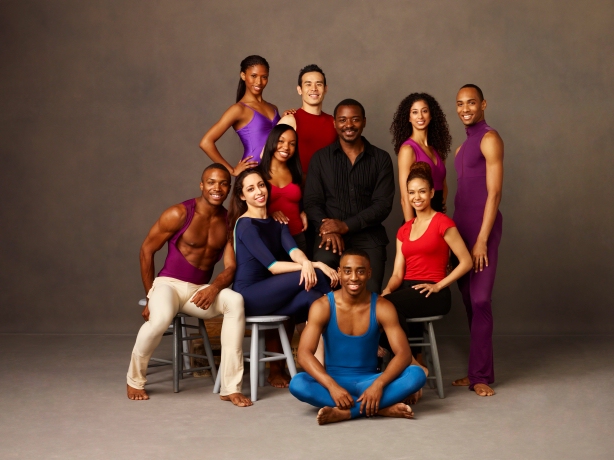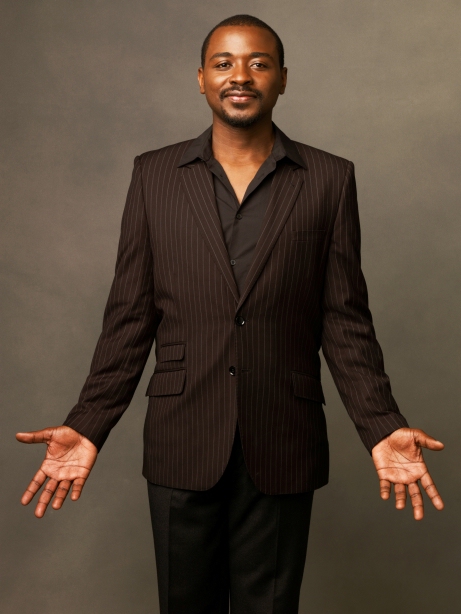
New Alvin Ailey American Dance Theater artistic director Robert Battle (c.) poses with dancers he has invited to join the company (photo by Andrew Eccles)
Alvin Ailey American Dance Theater
New York City Center
130 West 56th St. between Sixth & Seventh Aves.
November 30 – January 1, $25-$150
212-581-1212
www.alvinailey.org
www.nycitycenter.org
Founded in 1958, Alvin Ailey American Dance Theater had only two artistic directors over the course of its first fifty-two years, beginning with Ailey himself, who led the company until his death from AIDS in 1989, followed by Judith Jamison, who continued in the role through this summer, when in July she named her successor, Robert Battle. The thirty-eight-year-old Miami native has had a long affiliation with AAADT, having been an artist-in-residence since 1999, and he has had several works performed by the company, including “The Hunt,” “In/Side,” and “Love Stories,” a collaboration with Jamison and Rennie Harris.
Battle, who studied at Juilliard, danced with Parsons Dance Company, started his own group, Battleworks Dance Company, and was named a “Master of African American Choreography” by the Kennedy Center in 2005, is presenting his inaugural City Center season as AAADT artistic director from November 30 through January 1. The annual five-week event will feature Paul Taylor’s “Arden Court” (in his Ailey debut), Ohad Naharin’s interactive “Minus 16,” Jamison’s “Forgotten Time,” the world premiere of Harris’s AIDS-related “Home,” new productions of Joyce Trisler’s “Journey” and Alvin Ailey’s “Streams,” and several pieces by Battle, most notably the Ailey premiere of “Takademe.” Select performances of a number of works will include live music by such special guests as John Legend, Naren Budhkar, the Knights, and others. With the City Center season just a few weeks away, Battle talked with twi-ny about legacy, responsibility, and the precipice of discovery.
twi-ny: You are now only the third artistic director in the history of Alvin Ailey American Dance Theater. What is your greatest fear?
Robert Battle: I think that’s an unknown. Fear is not for me something that I turn on and off. Anybody, especially an artist, always has a healthy dose of fear mixed with optimism, because those two opposing forces is what creates energy, the energy that is the creative force. So I think it’s a healthy mixture of both of those things.
twi-ny: What are you looking forward to the most?
Robert Battle: I’m looking forward to watching and reveling at the dancers and the delights of the work that is coming in to the repertory and watching and being a part of taking the company into the future. That’s what I look forward to the most.
twi-ny: How did you go about selecting and grouping the dances for this year’s City Center season, which includes the company premiere of your own “Takademe”? Were you looking for an overriding theme?

Robert Battle has taken over the reins of Alvin Ailey American Dance Theater from Judith Jamison (photo by Andrew Eccles)
Robert Battle: Yes, the overriding theme is past, present, and future. We’re a repertory company — in a way, we’re a repository for great modern dance works — so, of course, looking back at Mr. Ailey’s work, Joyce Trisler’s “Journey,” created in 1958, all of these works are part of looking back and new productions of those works. Being in the present, looking at Rennie Harris’s work and his commission [“Home”] — he’s a hip-hop choreographer, so he uses hip-hop as his language. That is a part of the present; hip-hop is on everybody’s mind, radio, whatever it may be, but dealing with hip-hop to tell the stories of people who are surviving and thriving with HIV/AIDS is a wonderful tribute because it’s about the celebration of life. And then looking at works to me that echo the future, like Ohad Naharin’s “Minus 16,” which breaks the fourth wall: It invites the audience onto the stage, it has audience participation, it has a whole new way of moving for the dancers. So in that way we’re looking at the future. So we’re looking at all three of those things.
twi-ny: Who are some of the new choreographers you’d like to bring into the extended Ailey family?
Robert Battle: Aha — that, I cannot say [laughs], with deference to all choreographers who may want to be a part of this. I can’t just list one or two, but I really want the work to express the complexity of the world, society. It should be a reflection of that, so that you have choreographers of different races and backgrounds and approaches and themes bringing their voice to our voice. That’s what Mr. Ailey wanted, what Ms. Jamison continued, and what I will continue, to look far and wide, and to keep the audience and the dancers on that precipice of discovery.
twi-ny: With that in mind, how are you balancing the Ailey tradition with, perhaps, the urge to bust things wide open and initiate potential change under your leadership?
Robert Battle: I think that question could have a period at the end. That is what I am doing, balancing the traditional with the sometimes nontraditional. I think the notion of doing something without it having some connection to what is already here is not something I’m interested in. I’m really interested in blending the two. And that’s because this is a repertory company; that’s why I’m able to do that. If it’s one choreographer’s work, it’s harder to do that, but when you’re choosing works from many different choreographers in one season you get the sense of that yin and yang, that stretching forward of busting the whole thing wide open but yet keeping the traditional so that the company stays rooted. That’s why it began in the first place; celebrating the African American tradition and culture and experience in this country but also expanding on that idea is what I’m trying to do.